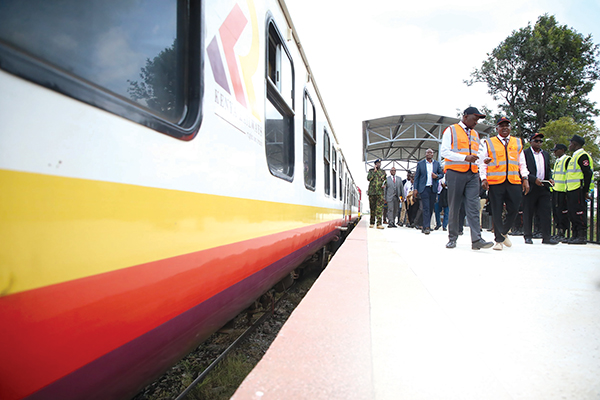#20
KENYA RAILWAYS
Efficient transport systems are the lifeblood of any thriving economy, facilitating the movement of goods and people, fostering trade, and stimulating industrial development.
Robust and reliable transportation infrastructure is crucial for a nation’s progress, and in Kenya, Kenya Railways stands as a cornerstone of this framework. With a rich history dating back over a century, Kenya Railways continues to drive economic activity and connect communities across the country. Its enduring role in Kenya’s development cements its position as a top corporation driving business in the region.
The history of rail transport in Kenya is steeped in the late 19th-century vision of the British colonial powers. Amidst fervent debates in the British Parliament, construction of the railway line through East Africa began on May 30, 1896. The undertaking was monumental, navigating uncharted territories and facing myriad challenges, from diseases and wildlife to rugged terrain and resistance from local tribes. The project, known as the Uganda Railway, pushed forward under the leadership of British engineers and the labour of Indian workers, known as ‘coolies’.
Kenyan folklore speaks of Syokimau, a Kamba prophetess, who foretold the arrival of a ‘long iron snake’ – a prophecy that came to life as the railway wound its way inland from the coast.

Despite numerous obstacles, including malaria, dysentery, and the infamous man-eating lions of Tsavo, the railway pressed on, reaching the swampy area of Nyrobi (modern-day Nairobi) by 1899. This once quiet habitat for Maasai pastoralists transformed into a bustling city, fueled by the railway’s presence.
By 1901, the line reached Port Florence (now Kisumu), symbolising a triumph of engineering and the dawn of modern Kenya. Settlements sprouted along the route, sparking trade and economic growth. Dubbed the ‘Lunatic Line’ for its staggering cost and the extreme challenges faced during construction, this railway laid the foundation for Kenya’s development. It facilitated the Northern Corridor, a critical trade route that remains central to Kenya’s economic strategy to-date.
Kenya Railways has continually evolved to meet contemporary demands. The launch of the Standard Gauge Railway (SGR) marked a significant modernisation effort, enhancing capacity and efficiency. Construction began in 2015, and by 2017, the SGR service was officially launched, connecting Mombasa to Nairobi with the swift and reliable Madaraka Express.
In 2019, the SGR network was expanded with the launch of the Nairobi to Suswa line, creating a crucial rail link that not only enhances transportation but also stimulates economic activities in the region.

Since its inception, the SGR has demonstrated impressive performance, consistently generating higher revenues. As of the financial year ending June 30, 2023, the SGR reported revenues of KES 18.2 billion, a 21.2 percent increase from the previous year. This growth underscores the SGR’s crucial role in Kenya’s logistics and passenger transport sectors. In 2022, the SGR earned KES 12.7 billion, up from KES 12.2 billion in 2021, with freight volumes rising by 12.6 percent to 6.09 million tonnes and passenger numbers reaching 2.52 million.
Despite a slight decline in container traffic at the Port of Mombasa, the SGR has maintained high demand due to its reliability and convenience. These achievements highlight Kenya Railways’ pivotal role in the nation’s economic infrastructure and its ongoing contribution to business growth.
Looking forward, Kenya Railways has laid out an ambitious roadmap in its 2023-2027 Strategic Plan. This plan outlines six Key Results Areas (KRAs) and seven strategic objectives aimed at bolstering the rail transport sector’s contribution to national growth. The focus areas include investing in new railway infrastructure, revitalising the existing Meter Gauge Railway line, and enhancing human capacity to support the corporation’s mandate.

Key initiatives over the next five years include resource mobilisation and the advancement of the Railway Cities project, particularly the Nairobi Central Railway Station area. This strategic location is poised to become a central hub in the Nairobi Multimodal Transport System, featuring mixed-use commercial developments, hotels, and intermodal facilities. The plan incorporates a comprehensive monitoring and evaluation framework to ensure effective implementation and the achievement of set targets.
Under the leadership of Philip Mainga EBS, Managing Director (MD) of Kenya Railways since February 2019, the corporation is well-positioned to navigate its strategic vision. Mainga’s extensive experience, spanning 19 years in various roles including Corporate Planning, Project Management, and Business Management, equips him with the expertise needed to drive Kenya Railways forward. He holds advanced degrees in Project Planning, Management, and Economics from the University of Nairobi (UoN) and the University of Mysore (UOM), India.
Mainga’s professional training, including courses at Harvard University and the World Bank Institute, further enhances his capacity to lead Kenya Railways in its mission to modernise and expand.
His recognition as an Elder of the Burning Spear (EBS) by the President of Kenya and recipient of the Star Person of the Year Award in 2020 underscores his significant contributions to the sector.
As Kenya Railways continues to innovate and expand, it remains a vital driver of business, connecting markets and fostering regional integration. Under visionary leadership, the corporation is set to remain a cornerstone of Kenya’s economic growth and development, enhancing its regional leadership for years to come.
















